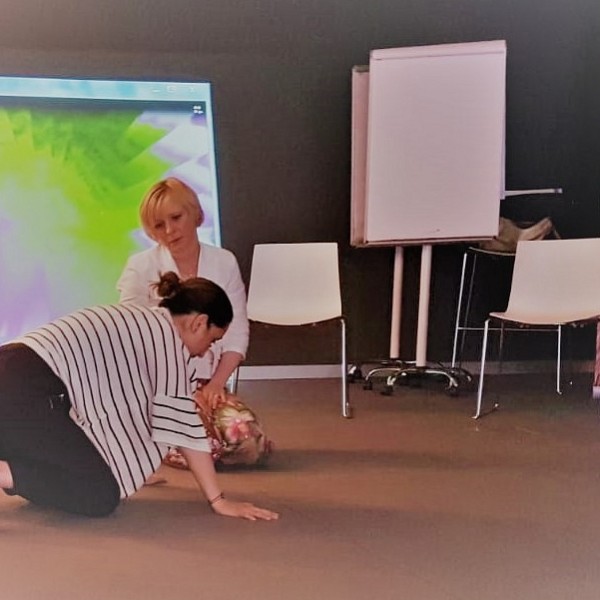Coaching praksa prikaz z uporabo Jungian in Expressive Arts metodologije
Why I believe Jungian and EAC modalities are transformative coaching - live coaching demonstration by Jasna Knez
It is so amazing how Jungian and Expressive Arts Coaching works. It is powerful tool when words are simply not enough. To discover and diagnose the real underlying issues of an individual or an organization and showing the way how to move stuck energy in order to solve them.
During my module in Expressive Arts in Coaching (teaching role), I held live coaching demonstration, where we all experience how I approach or applied Jungian and EAC methodology in my coaching practice. I like to combine methodology, depends on the need of a client, because I believe there is no one way to do it. Each of us is unique, as method to work with, needs to be.
Underlaying that this was study progress for students, it was meant to show step by step approach and beyond thinking strategy of coaching process. But due we worked hard in the module, we got really great case to learn from.
With a client, we started by just talking about what is going on. During days spent together we had established very good rapport and defense mechanisms were quite low. So first step was to discover what a real issue for a client is? I needed to hear and recognize client thoughts. Reexamine how client perceive the issue and how it reflects in her everyday life and business. It was all about good observation and listening of all levels: body, emotions and mind. Using embodied approach, I manly focus on my feelings/sensations - I felt stacked energy in the place.
On cognitive level we could spend hours of dialoging and not to move or make real necessary changes or achieve momentum. Why? We all have a default mode of operation. A way that we think and how we do things in life. We talk like we think we should.
But with Expressive Arts and Jungian coaching methods we progressed more meaningfully; client opens new horizons-perspectives, unconsciously express the core issues by using third object (not identifying with the problem, but become). Then understands that she or he can affect positive change and at the end forming new habits or way of approaching to things in life.
Using Jungian approach, aesthetic distancing out of the problem was first necessary step in demo work. Encouraging client to use symbolic thinking, she express her real issue why things don't work for her. Identifying the problem, I chose and empowered her to talk in metaphors of animal world. It goes from instinct and depressed energy in client body - how she sit, how she talk, weak voice, ect..).
As we could immediately guess from the chosen symbol, it might have underlying issues with fear of success and self-esteem. But it is not for me to guessing, I need to discover.. And jet, client holding to belief it is hard, having trouble owning what’s going on. Caught in the fear trap, she blames outside world of life events attempts to run away from the problem.
By helping client get unstuck, client can change the internal narrative that will help her.
We used change of modalities (embodied approach) to enable the client to express what was stuck. By empowering that she can do it, I used also myself to reflect and to overcome the fear to try it. She could connect to the power in her (in our case courage – symbolically for client tiger who eats the rat).
With the insight we were only on half way. Experience itself means nothing if we don’t do anything with it, so momentum was not there yet.
Using EAC, by putting insight to something creative (use of arts – new modality), client could express it in the third object, put it out, verbalized in her own way.
It was needed to bring to the awareness, to become, experience and to dialogue between themselves, fear and courage - tiger and rat, by use of activating the art and gestalt approach.
By activating the art in second part of the process client could experience and get answers for what needs to be changed. Touching the unconsciousness triggered a very productive inner debate in which client determined several activities that will help her to deal with the issues.
At the end bringing to the cognitive level is necessary. By being concrete to adjust and for her to decide how this can be applied in her everyday life that will lead to a very effective behavior for her. The last part we used cognitive wrap up way with concrete steps that client can and will start doing, to progress and overcome the issue. For her it was necessary to recognize when she is reacting to the fear directives and how to take in charge. It was crucial for client to recognize that some of the limits she has imposed upon herself may not actually exist but were invented in her thoughts. She was motivated to put the effort to change it, step by step. An exciting journey started for her.
At the end we shared some common thoughts: work on one thing only, start slow, if you fail, don’t give up, celebrate success and keep simple progress which will do wonders for her confidence. Sing and dance the life.
This was only a demonstration of how to use Expressive Arts in Coaching but it gives insights of its power.
Jasna Knez, Executive & Jungian Master Coach





